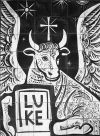
Jesus in Capernaum Lk 4,31-44
Luke and Mark
As we discovered in the overview, Luke is now following the sequence of events found in chapter 1 of Mark: the cure of a demoniac (4,31-37)
is followed by the cure of Peter's Mother in Law (4,38-39).
Then there is a summary of other healings (4,40-41) before Jesus leaves for a deserted place (4,42-44 = Mk 1,35-39). This takes us to the end of Luke chapter 4.
The final incident in Mark chapter 1 is the cure of the leper, Mk 1,40-44. In Luke we find this healing in 5,12-16. The call of Simon Peter, 5,1-11, has been inserted before this.
Luke will now be continuing to follow Mark closely for several chapters, as we will see as we go along. We will be considering this further when we read the next chapter.
In Capernaum
We can begin with the word that occurs three times: "rebuke" is found in verses 35, 39 and 41. As verse 41 in particular makes clear, Luke regards the healings as exorcisms. As we saw with the Temptation of Jesus at the beginning of this chapter, the devil is a rival source of power to the Spirit. Through this chapter from Temptation to healings, the devil is no match for Jesus who acts in the power of the Spirit (4,14 cf. 4,36) and with authority. Luke prefers to speak of the devil (4,33) instead of an unclean spirit (Mk 1,26).
The importance of the word is a major theme for Luke throughout the Gospel and Acts. So in the healing of the demoniac, 4,31-36, he twices alters Mark to bring out the authority of the word of Jesus (verses 32 & 36).
In the healing of Simon's mother in law, 4,38-39, it is not clearly said that Simon himself is present whereas in Mark's Gospel Simon and Andrew have already been called by Jesus. Luke stresses the power of Jesus by making her illness a high fever. There is then the request for the healing, "they besought him for her". As in Mark (but not Matthew, Mt 8,15), the woman then serves them. The presence of the disciples is implied. Luke adds "immediately" to this.
For the summary in verses 40-41, Luke stresses the variety of diseases. Unlike the mother in law where Jesus stood over her, Jesus now lays hands on the sick. Not all the healings therefore are exorcisms. Yet in verse 41 the devils are again involved and unlike "holy one of God" earlier (4,34, cf Mk 1,24), the devils are now explicit in calling Jesus "Son of God".
Then Jesus goes away to a desert place (4,42), but Luke does not mention Jesus at prayer as in Mark (Mk 1,35), even though comments about Jesus at prayer are more characteristic of Luke than Mark. Luke omits Peter hunting out Jesus as in Mk 1,36-37. Luke is generally kinder to the disciples or apostles than Mark. It is also typical of Luke to speak in verse 43 of "the good news (gospel) of the kingdom of God" - looking back to Jesus in the synagogue speaking of good news to the poor (4,18). This is Luke's first mention of the kingdom or reign of God.
Luke's changes to Mark therefore bring out a number of his characteristic themes. We will be seeing more of these as we go along.
We can now return to the main page
